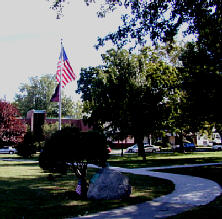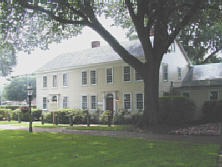WEST SPRINGFIELDMASSACHUSETTS |
 |
WEST SPRINGFIELDMASSACHUSETTS |
 |
West Springfield was incorporated near the beginning of the American Revolution in 1774. Two years after its incorporation, Henry Knox and his train of artillery passed through the town as noted by the Knox Trail marker on the common.
Three years after, General Reidesel and his Hessian soldiers, part of Burgoyne’s army, encamped on the village common on their way to imprisonment in Boston. The event is also indicated by a marker on the common.
 |
Here encamped Oct 30 and 31, 1777, General Riedesel and his Hessian soldiers on their way to Boston after Burgoyne’s surrender at Saratoga. This tablet was placed by George Washington Chapter, Sons of the American Revolution, Springfield, Massachusetts, A.D. 1904. (West Springfield Marker) |
One house still stands near the common that was a witness to these events. On the north side of the common, on Park Street, is the Josiah Day House, built in 1754. As the marker indicates, it is the only known solid brick salt box house of its period in the United States.
 About
a mile south of the common is the home of the Eastern States Exposition, one of
the largest fairs in the country. If you ever visit West Springfield in
mid-September, the crowds make it a little crazy around here. However, nestled
in a small corner of the fairgrounds is a year-round exhibit — The Storrowton
Village Museum. Storrowton is a colonial village that was created through the
efforts of Helen O. Storrow, who took abandoned buildings, moved them here and
restored them. The museum is open daily for most of the summer from 9 AM to 5PM
and year-round by appointment.
About
a mile south of the common is the home of the Eastern States Exposition, one of
the largest fairs in the country. If you ever visit West Springfield in
mid-September, the crowds make it a little crazy around here. However, nestled
in a small corner of the fairgrounds is a year-round exhibit — The Storrowton
Village Museum. Storrowton is a colonial village that was created through the
efforts of Helen O. Storrow, who took abandoned buildings, moved them here and
restored them. The museum is open daily for most of the summer from 9 AM to 5PM
and year-round by appointment.
Connecticut River -- Basketball fans may find the it difficult to continue their Revolutionary Day with the Basketball Hall of Fame just a half-mile south on the eastern banks of the river.
